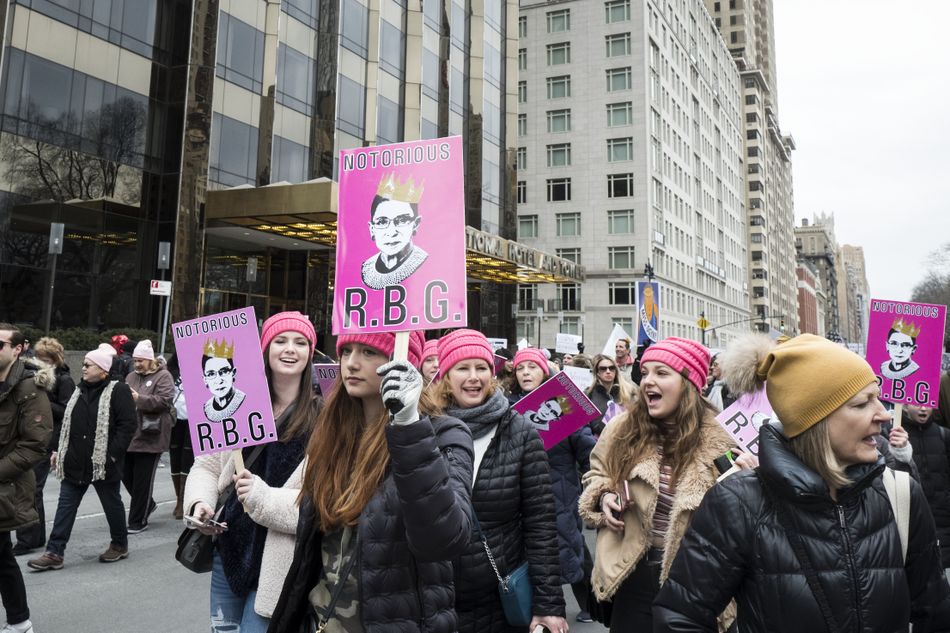When Supreme Court Justice Ruth Bader Ginsburg was 80 years old, she became an internet icon.
A law student started a Tumblr in her honor in 2013, dubbing her “The Notorious R.B.G.” and in the years that followed, she became a meme that lined Etsy sellers’ pockets. As much as her photo was flung around social media, her crowned head was emblazoned on T-shirts, her signature lace collar was reimagined as baby bibs, and she became “our lady of dissent” on votive candles you could buy for $15. Her internet domination both fueled and was fueled by her caricaturing on Saturday Night Live as a spunky old lady who could lift weights and kick ass. She particularly liked a popular T-shirt that read, “You can’t spell truth without Ruth.” She kept her own supply of R.B.G. T-shirts, handing them out to friends.
When she died Friday at 87, swathes of people under 30 only knew her as the meme queen people love on Instagram, Twitter, and TikTok. Her internet clout became the bridge that helped her cross generations.
“Everyone wants to take a picture with me,” she joked in RBG, the documentary about her life from 2018.
To top it off, her meme has meaning beyond the lulz: She wasn’t a punchline; she was a role model. She symbolized standing up for what’s right when you’re outnumbered. She wasn’t just a justice, she was justice. She also made for a cute Halloween costume for little kids and dogs, the ultimate shareable content.
In the ’50s, Ginsburg was one of nine women in her Harvard Law School class of over 500. In the ’70s and ’80s, she was a powerhouse lawyer fighting for constitutional protections against sex discrimination. In the ’90s, she took on new prestige as the second woman to be nominated to the Supreme Court. For a few years in the 2000s, she was the only woman on the bench, feeling lonely. Her dissent opinions took on a new edge, sharp and forceful. By 2013, when that Tumblr graced the internet, she was known, but mostly in political and legal circles. In those circles, she was still described as collegial. She was after all “best buddies,” with conservative Justice Antonin Scalia, who died in 2016. In 2020, she was known as the last liberal fortress, a protector against Trump putting another one of his Supreme Court picks on the bench. Following the news of her death, TikTok flooded with videos of people shedding tears of grief and cursing 2020. On Twitter, too, the F-bombs abounded. They also ricocheted across liberal corners of social media every time she went to the hospital over the past few years. She died of complications from pancreatic cancer, but it wasn’t her first stint with the Big C. She also at points battled colon, lung, and liver cancer.
Ginsburg first heard about the Tumblr from a law clerk. “My grandchildren love it, and I try to keep abreast of the latest that’s on the Tumblr,” she said in 2014.
Its creator, Shana Knizhnik, now a public defender, told The New Republic that year, that the nickname was “obviously a reference to Notorious B.I.G., who is this large, imposing rapper, a really powerful figure; and Ruth Bader Ginsburg is this 90-pound Jewish grandmother. The juxtaposition of the two made it humorous, but is also a celebration of how powerful she really is.”
It spiraled from there. In 2015, a book about Ginsburg’s life was published with the same name. Kate McKinnon started impersonating her on SNL during “Weekend Update” that year as well.
In one of her first impressions, McKinnon shot out the phrase, “Ya just got Gins-burned” and started dancing. When later asked about the portrayal, Ginsburg joked, “I would like to say “Gins-burn” sometimes to my colleagues.”
[embedded content]
Like anything online, not everyone’s a fan. Some pointed out that the memes put too much weight on Ginsburg’s slight shoulders as her health deteriorated. By 2018, they took on a cruel edge: Fight RBG, you may be very sick, but you must save us! There was also the argument that the memes turned her into a superhero, buffing out all her blemishes. That often happens when one becomes flattened by the fast-churning gears of the social media machine.

Marchers with signs that say “Notorious R.B.G.” with a picture of Ruth Bader Ginsburg at the January 2019 Woman’s March in Manhattan.
Image: Ira L. Black / Corbis via Getty Images
Despite the criticism, much of it warranted, Ginsburg’s internet alter ego taught a new generation about a trailblazing woman who stood for equality. Amid the #MeToo movement marked both by horrendous accusations of sexual harassment and hopeful women’s marches, the Notorious R.B.G. evolved to represent something bigger than herself. For her admirers, she wasn’t only the protector of the highest court in the land. She wasn’t solely a historical figure. She was, right then, a talisman, a magnet, a buoy in tumultuous waters. At makeshift vigils set up in her honor Friday night, Notorious R.B.G. imagery could be spotted among the multitude of flowers and candles.
[embedded content]
“It was beyond my wildest imagination that I would one day become the Notorious R.B.G.,” Ginsburg said last year during a speech at a university.
But it was in our imaginations that the Notorious R.B.G. thrived. The internet’s version of Ginsburg will live on, adding yet another aspirational element to her legacy. When we imagine a more equitable world, she is right there along with us. When we finally build that world, we will have Ginsburg and the Notorious R.B.G. to thank.
